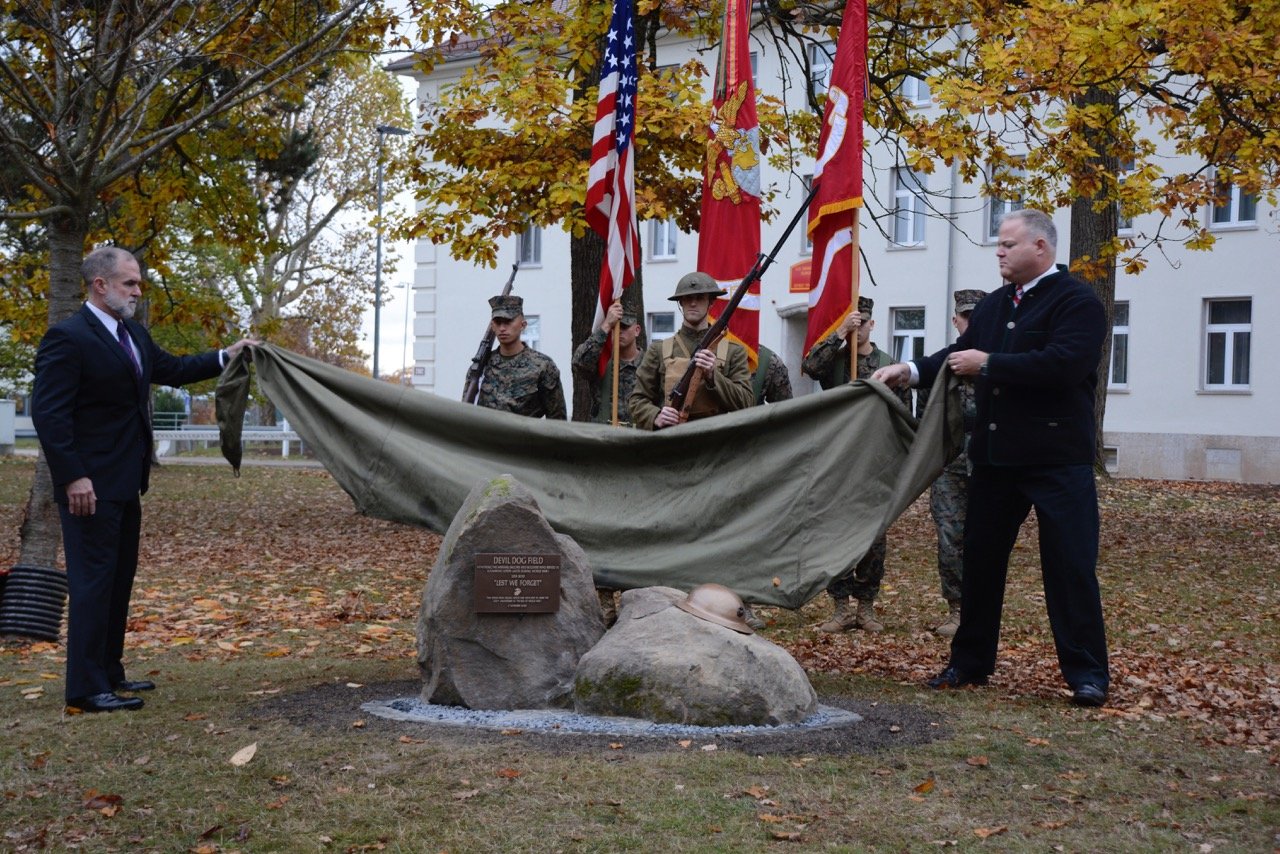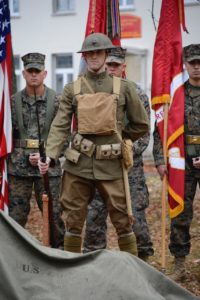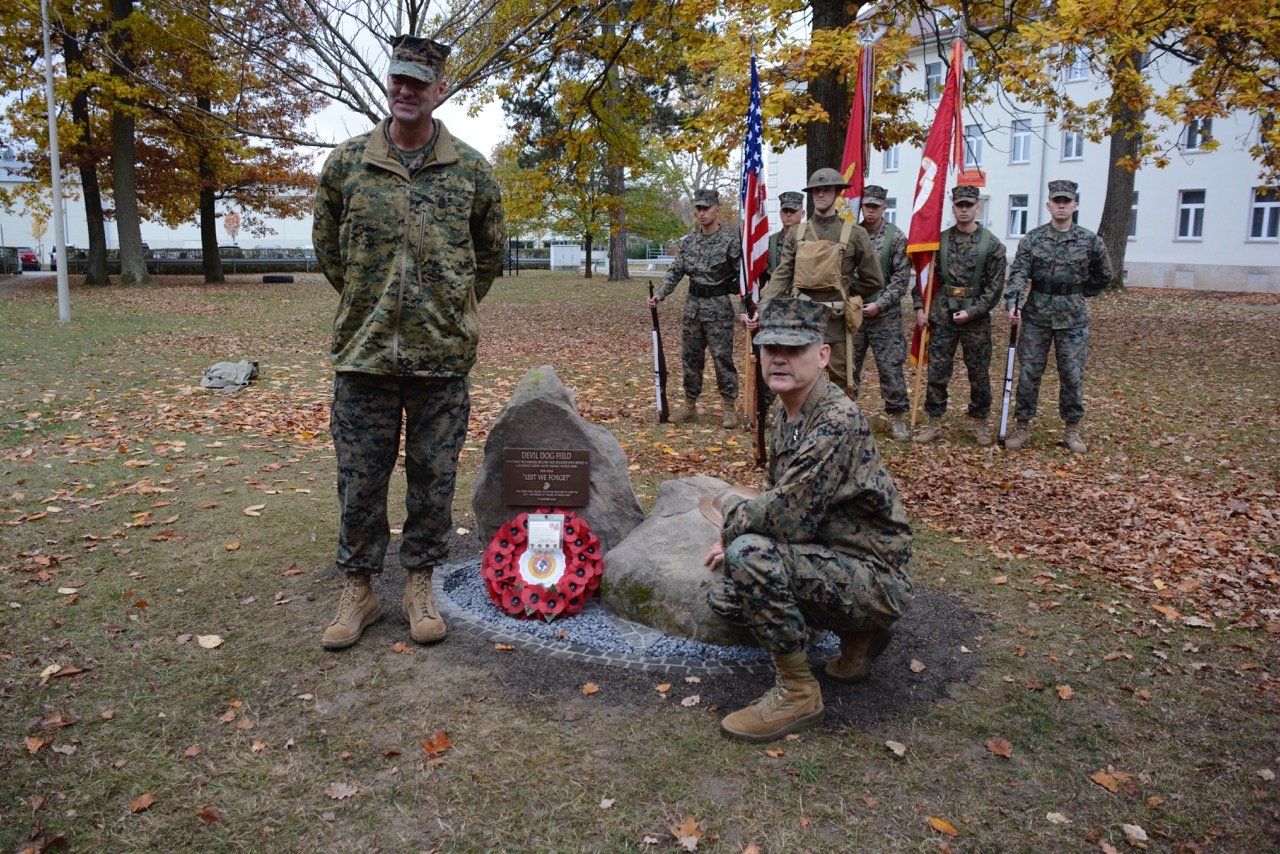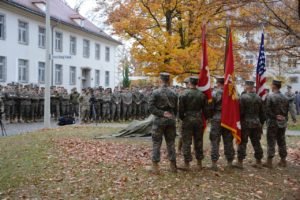
By David S. Jones
U.S. Marine Forces Europe & Africa
The U.S. Marine Corps has long been associated with the Battle of Belleau Wood and its role in stopping the German advance on Paris in June 1918. But Belleau Wood was only the beginning of the story of the Corps in World War I as it would go on to fight at Soissons, St. Mihiel, Blanc Mont and the Meuse-Argonne, as well as fly bombing and pursuit missions over northern France and Belgium, anti-submarine missions out of the Azores, and serve as ship detachments on the sea lanes.

To commemorate that service and sacrifice across the battlefields of Europe on the 100th anniversary of the end of World War I, Maj. Gen. Russell A. Sanborn, commander, U.S. Marine Corps Forces Europe and Africa, dedicated the parade ground in front of the MARFOREUR/AF headquarters, Nov. 8, as “Devil Dog Field” to recognize the nickname the Marines earned in World War I after their fight at Belleau Wood. Sanborn dedicated a memorial that recognizes the Marines, Sailors, and Soldiers that comprised the units fielded by the Marine Corps in the American Expeditionary Force.
World War I consumed millions of lives and forever changed the world, Sandborn said, adding that the the service and sacrifices of the AEF forces were a decisive factor in ending the war and set the Corps on the path to the modern fighting force that it has become.
“The names Belleau Wood, Soissons, St. Mihiel, Blanc Mont and Meuse-Argonne will forever be remembered as the Corps’ baptism of fire with modern warfare from which future generations would carry the torch on the battlefields of Guadalcanal, Iwo Jima, Chosin, Hue, Fallujah and many other battlefields around the globe,” Sandborn said.
Marines gathered on the chilly fall morning to witness the unveiling are familiar with the Belleau Wood legacy. With the 100th anniversary of the war’s end and their assignment in Germany, they now have a better appreciation of the battles the Marines would go on to fight in the last five months of World War I and the many American cemeteries in France where the fallen are interred.

The Devil Dog Field memorial is comprised of two stones from Belleau Wood, France, donated by a French farmer, featuring a bronze plaque and bronzed World War I U.S. doughboy helmet. It rests on an oval pad of dark cobblestones in the shape of the 4th Marine Brigade’s shoulder patch worn when the brigade entered Germany on Dec. 1, 1918, to serve with the army of occupation along the Rhine River until August 1919. The memorial was made possible by private donations.
World War I was a crucial turning point in Marine Corps history, as the service would depart its traditional shipboard and small wars role and prove itself on the fields of modern industrialized warfare. The war would also be the proving ground for many young leaders who would later be key commanders that would fight and win the Pacific campaigns of World War II.
“Marines take their traditions very seriously,” said Sgt. Maj. Michael P. Woods, senior enlisted adviser, MARFOREUR/AF. “We love the fact that 100 years ago, on the battlefields of Belleau Wood, France, the Germans called the Marines who fought there in that battle ‘Devil Dogs’ because of their tenacity, their fierceness.”

Additionally, the Marines fielded units with not only the traditional Navy medical personnel, but also with Army officers who served from platoon to brigade level within the 4th Marine Brigade. Marine officers would also serve in, and in some cases command, Army units of the 1st, 2d, 3d, 4th, 6th, 27th, 32d, 35th, 90th, and 92d Divisions of the AEF. And for the only time in Marine Corps and Army history, a Marine would command an Army division in combat when Maj. Gen. John A. Lejuene assumed command of the 2d Division on July 28, 1918, until its return to the U.S. in August 1919.
“It was because of what happened in World War I, really, because of how the Marines fought in World War 1, that I believe they exist today,” Woods said.
With the dedication of Devil Dog Field, every Marine assigned to MARFOREUR/AF will have a daily reminder of those that came before them in the fight for freedom in Europe.
(Editor’s note: John Reese, USAG Stuttgart Public Affairs, contributed to this article.)
